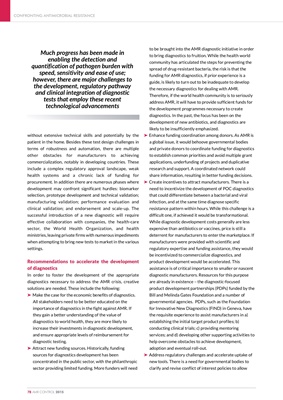
without extensive technical skills and potentially by the
patient in the home. Besides these test design challenges in
terms of robustness and automation, there are multiple
other obstacles for manufacturers to achieving
commercialization, notably in developing countries. These
include a complex regulatory approval landscape, weak
health systems and a chronic lack of funding for
procurement. In addition there are numerous phases where
development may confront significant hurdles: biomarker
selection, prototype development and technical validation;
manufacturing validation; performance evaluation and
clinical validation; and endorsement and scale-up. The
successful introduction of a new diagnostic will require
effective collaboration with companies, the health-care
sector, the World Health Organization, and health
ministries, leaving private firms with numerous impediments
when attempting to bring new tests to market in the various
settings.
Recommendations to accelerate the development
of diagnostics
In order to foster the development of the appropriate
diagnostics necessary to address the AMR crisis, creative
solutions are needed. These include the following:
‰ Make the case for the economic benefits of diagnostics.
All stakeholders need to be better educated on the
importance of diagnostics in the fight against AMR. If
they gain a better understanding of the value of
diagnostics to world health, they are more likely to
increase their investments in diagnostic development,
and ensure appropriate levels of reimbursement for
diagnostic testing.
‰ Attract new funding sources. Historically, funding
sources for diagnostics development has been
concentrated in the public sector, with the philanthropic
sector providing limited funding. More funders will need
to be brought into the AMR diagnostic initiative in order
to bring diagnostics to fruition. While the health world
community has articulated the steps for preventing the
spread of drug-resistant bacteria, the risk is that the
funding for AMR diagnostics, if prior experience is a
guide, is likely to turn out to be inadequate to develop
the necessary diagnostics for dealing with AMR.
Therefore, if the world health community is to seriously
address AMR, it will have to provide sufficient funds for
the development programmes necessary to create
diagnostics. In the past, the focus has been on the
development of new antibiotics, and diagnostics are
likely to be insufficiently emphasized.
‰ Enhance funding coordination among donors. As AMR is
a global issue, it would behoove governmental bodies
and private donors to coordinate funding for diagnostics
to establish common priorities and avoid multiple grant
applications, underfunding of projects and duplicative
research and support. A coordinated network could
share information, resulting in better funding decisions.
‰ Create incentives to attract manufacturers. There is a
need to incentivize the development of POC diagnostics
that could differentiate between a bacterial and viral
infection, and at the same time diagnose specific
resistance pattern within hours. While this challenge is a
difficult one, if achieved it would be transformational.
While diagnostic development costs generally are less
expensive than antibiotics or vaccines, price is still a
deterrent for manufacturers to enter the marketplace. If
manufacturers were provided with scientific and
regulatory expertise and funding assistance, they would
be incentivized to commercialize diagnostics, and
product development would be accelerated. This
assistance is of critical importance to smaller or nascent
diagnostic manufacturers. Resources for this purpose
are already in existence - the diagnostic-focused
product development partnerships (PDPs) funded by the
Bill and Melinda Gates Foundation and a number of
governmental agencies. PDPs, such as the Foundation
for Innovative New Diagnostics (FIND) in Geneva, have
the requisite experience to assist manufacturers in a)
establishing the initial target product profiles; b)
conducting clinical trials; c) providing mentoring
services; and d) developing other supporting activities to
help overcome obstacles to achieve development,
adoption and eventual roll-out.
‰ Address regulatory challenges and accelerate uptake of
new tools. There is a need for governmental bodies to
clarify and revise conflict of interest policies to allow
CONFRONTING ANTIMICROBIAL RESISTANCE
78 AMR CONTROL 2015
Much progress has been made in
enabling the detection and
quantification of pathogen burden with
speed, sensitivity and ease of use;
however, there are major challenges to
the development, regulatory pathway
and clinical integration of diagnostic
tests that employ these recent
technological advancements